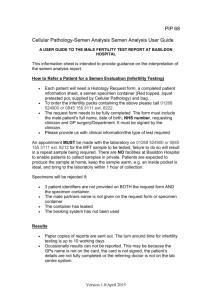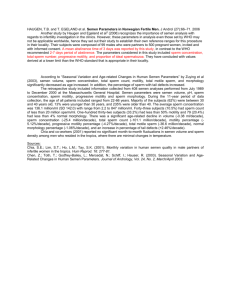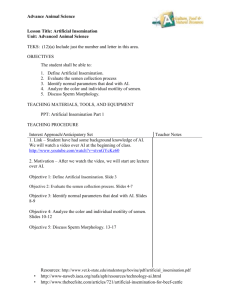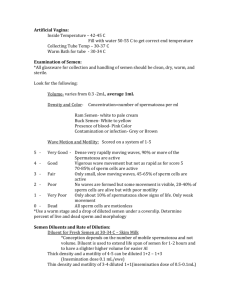Semen Evaluation
advertisement
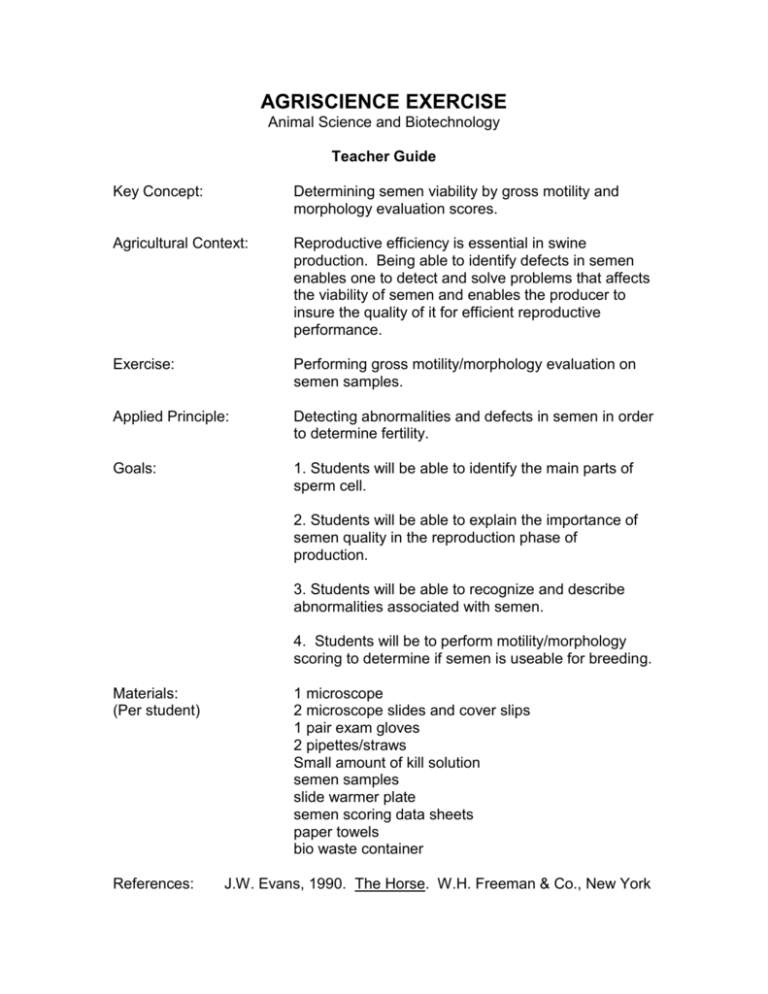
AGRISCIENCE EXERCISE Animal Science and Biotechnology Teacher Guide Key Concept: Determining semen viability by gross motility and morphology evaluation scores. Agricultural Context: Reproductive efficiency is essential in swine production. Being able to identify defects in semen enables one to detect and solve problems that affects the viability of semen and enables the producer to insure the quality of it for efficient reproductive performance. Exercise: Performing gross motility/morphology evaluation on semen samples. Applied Principle: Detecting abnormalities and defects in semen in order to determine fertility. Goals: 1. Students will be able to identify the main parts of sperm cell. 2. Students will be able to explain the importance of semen quality in the reproduction phase of production. 3. Students will be able to recognize and describe abnormalities associated with semen. 4. Students will be to perform motility/morphology scoring to determine if semen is useable for breeding. Materials: (Per student) References: 1 microscope 2 microscope slides and cover slips 1 pair exam gloves 2 pipettes/straws Small amount of kill solution semen samples slide warmer plate semen scoring data sheets paper towels bio waste container J.W. Evans, 1990. The Horse. W.H. Freeman & Co., New York Teacher Background Information After making a preliminary boar selection, determining the initial quality of his ejaculate is the first step in deciding whether or not to use him in a breeding program. Effective screening methods for ejaculates, prior to processing the semen for AI uses or for natural services are necessary for a successful breeding program. With this in mind, the objectives of this exercise are to perform a simple motility and morphology evaluation and determine the semen’s acceptability by using a microscope and a composite scoring system based on percentage of motile cells and morphological defects of the sperm cells. Visual estimates of the percentage of motile spermatozoa by light microscopy are the most widely used and acceptable method. Technician skill and experience greatly influences the relative accuracy of this procedure. Like motility, a certain percentage of normal morphological spermatozoa are needed in order to optimize fertility rates. Research data supports that ejaculation with less than 70% normal sperm cells should not be used and can be identified as inferior. Like wise the motility acceptance level should be higher than 60% motile sperm present. Estimates of motility and morphology do not appear to be an estimate of fertility but instead are basic evidences of sperm viability. These described measurements are more likely to influence fertility through elimination of poor quality ejaculates as contrast to a predictor of the ejaculates ability to sire more piglets or impregnate a female. Prior to this lab exercise, the process of sperm production, causes and description of defects, and the impact that they have should have been taught in detail during the classroom lecture periods. In addition, each student should have knowledge and ability to use the microscope. Instructions and cautions concerning the risks of handling the glass slides, cover slips, kill solution, semen samples, and microscopes should be reiterated before moving forward in the exercise. Over applications can easily skew readings and overall evaluations. Due to some samples being too concentrated or agglutinated for proper evaluation of the semen sample, you can use a 1:1- 1:3 dilution of semen with an extender in order to thin it out for a better view of the sperm cell features and motility. The Structure and Components of Sperm Cells Sperm cells are specialized cells that function solely to fertilize eggs and are designed for this purpose. Normal sperm have a tail and a head. On the top of the head is a specialized region called the acrosome (cap). The acrosome contains enzymes that help the sperm cell penetrate the outer membranes of eggs, which is necessary to the fertilization process. If the acrosome is damaged, the sperm cell will not be able to fertilize an egg. Avoid exposing sperm to heat and cold shock, abrupt changes in pH or osmotic pressure, because these can damage the acrosome. (For this exercise, we will not be observing the acrosome; this will require another lab to learn staining techniques and/or would require the use of a phase contrast microscope.) The head of the sperm also contains the male genetic information that is carried into the egg at the time of fertilization. During fertilization, the male DNA merges with the female DNA to form the genotype of the new piglets. Most abnormalities are genetic and if a boar produces greater than 10% abnormal heads, he should be culled. The tail gives the sperm motility. Although motility is NOT how sperm cells get from the cervix to the oviduct, it IS how the sperm push their heads into the egg during fertilization. Thus, boars with non-motile sperm are infertile. Motility problems can be the result of genetic defects: these are manifested in coiled, double and filiform tails. Immotile sperm can also result nutritional deficiencies, health problems, environmental stress, etc. Bent tails usually indicate that the sperm has been stressed by heat or cold shock or an abrupt change in pH. The tails can also be stripped away from the heads if the sperm cell is exposed to mechanical stress or severe changes in osmotic pressure. During their maturation process, sperm develop a cytoplasmic droplet. The cytoplasmic droplet is a small drop that is located just below the junction of the head and the tail of a sperm cell (Proximal droplets). As sperm mature, they first acquire and then lose this cytoplasmic droplet. Sperm become mature enough to fertilize eggs just before the cytoplasmic droplet is lost. Thus, the presence or absence of a cytoplasmic droplet can be a crude indicator of how mature the sperm cell is. The position of the droplet is also important: the further the droplet is from the head of the sperm, the more likely it is that the sperm will be able to fertilize an egg. If the ejaculate of a mature boar contains many sperm (>20%) that have the cytoplasmic droplet, it means that the boar may have been overused: the mature sperm cells are being ejaculated faster than the younger cells can mature to replace them. If a younger boar has many sperm cells with cytoplasmic droplets, it can mean that he has not reached sexual maturity. Cytoplasmic droplets can sometimes become translocated, so that the droplet does not fall off but remains on the sperm (Distal droplets). Such sperm is abnormal and will probably not be able to fertilize an egg. During this lab exercise, students will be examining the semen samples for motility and for the abnormalities that we can see with our microscopes (tails, droplets etc.), without using a staining process at this time. As you familiarize yourself with this process, we will move into the staining of samples for further evaluation of semen samples. Procedures for Conducting the Activity Motility Procedures: 1. Locate and familiarize yourself with the microscope and adjustments, set the objective to 100X. 2. Obtain a pair of gloves and fit them onto hands for use. 3. Take one slide, cover slip and straw. 4. Take straw and dip end into semen sample. (This will be enough to get an adequate sample in most cases) 5. Gently touch the end of the straw onto the surface of the slide, leaving a tiny drop of semen on the surface of the slide. (Be careful to not get too much onto the slide, it will affect your ability to get a true reading.) 6. Place slide onto the microscopes stage and perform a coarse adjustment and then do a fine adjustment to where you can clearly see the sperm cells. 7. View the sample at 100X and then at 400X, pick an area in the field of view and count 10 cells. Of these 10 cells determine the number that are motile and record your finding in motility data sheet. 8. Move the stage to find another field of view on the same sample and repeat the process mentioned in step 7, for a total of 10 different fields of view. 9. Add the total number of motile cells observed in the 10 different fields of view and divide that number by the total number of cells observed and multiply by 100. This will be the motility percent of this particular sample. 10. Properly discard your slide. Motility Data Sheet Field #1 # Of motile cells #of non-motile cells total #of cells Field #2 # Of motile cells #of non-motile cells total #of cells Field #3 # Of motile cells #of non-motile cells total #of cells Field #4 # Of motile cells #of non-motile cells total #of cells Field #5 # Of motile cells #of non-motile cells total #of cells Field #6 # Of motile cells #of non-motile cells total #of cells Field #7 # Of motile cells #of non-motile cells total #of cells Field #8 # Of motile cells #of non-motile cells total #of cells Field #9 # Of motile cells #of non-motile cells total #of cells Field #10 # Of motile cells #of non-motile cells total #of cells Total sample results: # Of motile cells #of non-motile cells total #of cells Total # motile cells______/ total # of cells______ x 100 = ___________%motility Morphology Procedures: 1. Take one slide, cover slip and straw. 2. Take straw and dip end into semen sample. (This will be enough to get an adequate sample in most cases) 3. Gently touch the end of the straw onto the surface of the slide, leaving a tiny drop of semen on the surface of the slide. (Be careful to not get too much onto the slide, it will affect your ability to get a true reading.) 4. Locate the kill solution and dip the end of another straw into it and transfer it to the sample on your slide. Barely touch the sample, depositing a drop of kill solution onto it. 5. Cover the killed sample with a cover slip. 6. Place slide onto the microscopes stage and perform a coarse adjustment and then do a fine adjustment to where you can clearly see the sperm cells. 7. View the sample at 100X and then at 400X, pick an area in the field of view and count 10 cells. Of these 10 cells determine the number that have any morphological defects as discussed in class and the review session, and list them in the morphology score sheet by number and defect. 8. Move the stage to find another field of view on the same sample and repeat the process mentioned in step 9, for a total of 10 different fields of view. 9. Add the total number of defective cells observed in the 10 different fields of view and divide that number by the total number of cells observed and multiply by 100. Record your results. This will be the morphology percent of this particular sample. 10. Properly discard your slide. 11. Clean up work area. 12. Complete the rest of the lab exercise. Common Sperm Head, Mid Piece, Tail and Acrosome Abnormalities Normal Loose heads Dwarf-head Distal Cytoplasmic droplet Damaged tail Club—two spermatozoa joined together Proximal Cytoplasmic droplet Detached cap Gigantic-head Shoe hook Tail looped around head Swollen cap Pear-head Two (or more) headed Biscuit-head Head Neck & Midpiece Tail Undeveloped spermatozoon Threadlike midpiece Midpiece divided into fibers and mitochondria Morphology of spermatozoan Morphology Data Sheet Field #1 # Normal cells #abnormal cells # total # cells Field #2 # Normal cells #abnormal cells # total # cells Field #3 # Normal cells #abnormal cells # total # cells Field #4 # Normal cells #abnormal cells # total # cells Field #5 # Normal cells #abnormal cells # total # cells Field #6 # Normal cells #abnormal cells # total # cells Field #7 # Normal cells #abnormal cells # total # cells Field #8 # Normal cells #abnormal cells # total # cells Field #91 # Normal cells #abnormal cells # total # cells Field #10 # Normal cells #abnormal cells # total # cells Total # normal cells_____/ total # of cells x 100 = ______________% morphology How many different types of abnormalities did you notice in the samples that you observed? _____________________________________________________________. (Refer to your handout for names and identification of abnormalities.) Data Sheet: 1. Identify and label the major areas of the sperm cell that are marked below. 2. Where are cytoplasmic droplets formed and what problems does their presence indicate? 3. What is normally associated with bent tails? 4. Is the acrosomal cap an important part of the sperm cell? Why or why not? 5. Where is the genetic material, for transfer located in the sperm cell? 6. Is motility essential for transport? Explain. 7. What are proximal droplets? What is the primary cause of these in semen? 8. What are distal droplets? 9. Recalling our discussion prior to this lab exercise, what are DMR’s? 10. What was your gross semen motility score for this exercise? 11. What was your morphology score for this exercise? 12. Based on your evaluations would this semen be recommended for use? Why will we not be able to see the acrosomal caps during this exercise? What is necessary for us to be able to see these? AGRISCIENCE EXERCISE Animal Science and Biotechnology Student Guide Key Concept: Determining semen viability by gross motility and morphology evaluation scores. Agricultural Context: Reproductive efficiency is essential in swine production. Being able to identify defects in semen enables one to detect and solve problems that affects the viability of semen and enables the producer to insure the quality of it for efficient reproductive performance. Exercise: Performing gross motility/morphology evaluation on semen samples. Applied Principle: Detecting abnormalities and defects in semen in order to determine fertility. Goals: 1. Students will be able to identify the main parts of sperm cell. 2. Students will be learning the importance of semen quality in the reproduction phase of production. 3. Students will be able to identify abnormalities associated with semen. 4. Students will be to perform motility/morphology scoring to determine if semen is useable for breeding. Materials: (Per student) References: 1 microscope 2 microscope slides and cover slips 1 pair exam gloves 2 pipettes/straws Small amount of kill solution semen samples slide warmer plate semen scoring data sheets paper towels bio waste container J.W. Evans, 1990. The Horse. W.H. Freeman & Co., New York Procedures for Conducting the Activity Motility Procedures: 1. Locate and familiarize yourself with the microscope and adjustments, set the objective to 100X. 2. Obtain a pair of gloves and fit them onto hands for use. 3. Take one slide, cover slip and straw. 4. Take straw and dip end into semen sample. (This will be enough to get an adequate sample in most cases) 5. Gently touch the end of the straw onto the surface of the slide, leaving a tiny drop of semen on the surface of the slide. (Be careful to not get too much onto the slide, it will affect your ability to get a true reading.) 6. Place slide onto the microscopes stage and perform a coarse adjustment and then do a fine adjustment to where you can clearly see the sperm cells. 7. View the sample at 100X and then at 400X, pick an area in the field of view and count 10 cells. Of these 10 cells determine the number that are motile and record your finding in motility data sheet. 8. Move the stage to find another field of view on the same sample and repeat the process mentioned in step 7, for a total of 10 different fields of view. 9. Add the total number of motile cells observed in the 10 different fields of view and divide that number by the total number of cells observed and multiply by 100. This will be the motility percent of this particular sample. 10. Properly discard your slide. Motility Data Sheet Field #1 # Of motile cells #of non-motile cells total #of cells Field #2 # Of motile cells #of non-motile cells total #of cells Field #3 # Of motile cells #of non-motile cells total #of cells Field #4 # Of motile cells #of non-motile cells total #of cells Field #5 # Of motile cells #of non-motile cells total #of cells Field #6 # Of motile cells #of non-motile cells total #of cells Field #7 # Of motile cells #of non-motile cells total #of cells Field #8 # Of motile cells #of non-motile cells total #of cells Field #9 # Of motile cells #of non-motile cells total #of cells Field #10 # Of motile cells #of non-motile cells total #of cells Total sample results: # Of motile cells #of non-motile cells total #of cells Total # motile cells______/ total # of cells______ x 100 = ___________%motility Morphology Procedures: 1. Take one slide, cover slip and straw. 2. Take straw and dip end into semen sample. (This will be enough to get an adequate sample in most cases) 3. Gently touch the end of the straw onto the surface of the slide, leaving a tiny drop of semen on the surface of the slide. (Be careful to not get too much onto the slide, it will affect your ability to get a true reading.) 4. Locate the kill solution and dip the end of another straw into it and transfer it to the sample on your slide. Barely touch the sample, depositing a drop of kill solution onto it. 5. Cover the killed sample with a cover slip. 6. Place slide onto the microscopes stage and perform a coarse adjustment and then do a fine adjustment to where you can clearly see the sperm cells. 7. View the sample at 100X and then at 400X, pick an area in the field of view and count 10 cells. Of these 10 cells determine the number that have any morphological defects as discussed in class and the review session, and list them in the morphology score sheet by number and defect. 8. Move the stage to find another field of view on the same sample and repeat the process mentioned in step 9, for a total of 10 different fields of view. 9. Add the total number of defective cells observed in the 10 different fields of view and divide that number by the total number of cells observed and multiply by 100. Record your results. This will be the morphology percent of this particular sample. 10. Properly discard your slide. 11. Clean up work area. 12. Complete the rest of the lab exercise. Common Sperm Head, Mid Piece, Tail and Acrosome Abnormalities Normal Loose heads Dwarf-head Distal Cytoplasmic droplet Damaged tail Club—two spermatozoa joined together Proximal Cytoplasmic droplet Detached cap Gigantic-head Shoe hook Tail looped around head Swollen cap Pear-head Two (or more) headed Biscuit-head Head Neck & Midpiece Tail Undeveloped spermatozoon Threadlike midpiece Midpiece divided into fibers and mitochondria Morphology of spermatozoan Morphology Data Sheet Field #1 # Normal cells #abnormal cells # total # cells Field #2 # Normal cells #abnormal cells # total # cells Field #3 # Normal cells #abnormal cells # total # cells Field #4 # Normal cells #abnormal cells # total # cells Field #5 # Normal cells #abnormal cells # total # cells Field #6 # Normal cells #abnormal cells # total # cells Field #7 # Normal cells #abnormal cells # total # cells Field #8 # Normal cells #abnormal cells # total # cells Field #91 # Normal cells #abnormal cells # total # cells Field #10 # Normal cells #abnormal cells # total # cells Total # normal cells_____/ total # of cells x 100 = ______________% morphology How many different types of abnormalities did you notice in the samples that you observed? _____________________________________________________________. (Refer to your handout for names and identification of abnormalities.) Data Sheet: 1. Identify and label the major areas of the sperm cell that are marked below. 2. Where are cytoplasmic droplets formed and what problems does their presence indicate? 3. What is normally associated with bent tails? 4. Is the acrosomal cap an important part of the sperm cell? Why or why not? 5. Where is the genetic material, for transfer located in the sperm cell? 6. Is motility essential for transport? Explain. 7. What are proximal droplets? What is the primary cause of these in semen? 8. What are distal droplets? 9. Recalling our discussion prior to this lab exercise, what are DMR’s? 10. What was your gross semen motility score for this exercise? 11. What was your morphology score for this exercise? 12. Based on your evaluations would this semen be recommended for use? Why will we not be able to see the acrosomal caps during this exercise? What is necessary for us to be able to see these?

